Buying now and paying later is a growing trend in the world of online shopping.Oscar Wong/Getty Images This story is available exclusively to Insider subscribers.Become an Insider and start reading now.Buy now, pay later currently represents only 2% of global e-commerce volume.
But Bank of America analysts say that only suggests “ample room for additional penetration.” They shared their two top buys within the subsector to take advantage of surging growth potential.
Amidst the slew of sectors that have been transformed by the pandemic, e-commerce has been a clear COVID winner.
In 2020, e-commerce sales reached a record-shattering $813 billion — a 42% jump from 2019, Adobe reported.Data from the US Department of Commerce showed that total e-commerce sales for the first three quarters of 2021 reached $652.1 billion .And when accounting for the massive jump in shopping during the holidays, it’s extremely possible that total online sales in 2021 will climb to Adobe’s predicted range of $850 billion to $930 billion.
If the trend continues, Adobe forecasts that 2022 could very likely become e-commerce’s first trillion-dollar year.
That might be why some Wall Street investors are very bullish on an emerging subsector: buy now, pay later, or BNPL.
Buy now, reap the rewards later
Within e-commerce, BNPL currently represents only around 2% of global volume.But a team at Bank of America led by Senior Equity Research Analyst Jason Kupferberg wrote in a January 12 note that the number suggests “ample room for additional penetration over time, before even considering the potential in-store opportunity.”
According to Kupferberg, BNPL penetration has already reached around 20% in countries like Australia and Sweden, while it lags in the US at only about 3%.The rest of Europe, Central and South America, and Southeast Asia also “all represent opportunity for geographic expansion,” he said.
The BNPL system allows customers to pay for an item in installments , oftentimes free of interest and other fees.After paying the first installment at checkout, the customer receives the item immediately, while the rest of the payments are then billed to a debit or credit card later.
Using just a few personal data points, BNPL companies run a credit check for customers and individually customize the terms and interest fees for a purchase.During checkout, the BNPL firm then pays merchants in full, charging an additional percentage for taking on the consumer’s credit risk.The sole responsibility then falls on them to collect back payments on the item.
Top buys: Affirm, PayPal
Amongst the BNPL subsector, Kupferberg and his team specifically identified two “long-term winners” they rated as buys: Affirm ( AFRM ) and PayPal ( PYPL ).
According to Kupferberg, global BNPL app downloads across app providers grew by 36% in December 2021, versus 21% in November.
Global monthly active users also grew across the board by 53% in December, versus November’s 50%.
Even though privately held BNPL company Klarna was the “key driver” for the acceleration in both metrics, Affirm also saw “stable trends,” with its December US app download growth the “highest absolute level of growth among providers,” Kupfenberg wrote.
Notably, Affirm was also the only provider to have growth accelerate in the second half of 2021 versus the first half.
As of December, Affirm climbed to second place after Klarna to be the most popular US BNPL app.It also enjoyed the “most evidence of market share gains” among BNPL companies, controlling 24% of total BNPL app downloads in December alone versus 18% in the entire first half of 2021.
“Given the robustness in BNPL trends and company-specific dynamics, we believe AFRM is seeing positive momentum, especially in the non-Peloton part of the business,” said Kupfenberg.
Kupfenberg and his team also examined a Morning Consult survey to determine the “relative brand popularity and recognition” of BNPL providers amongst US consumers.The results showed that “PayPal’s Pay in 4 remains the most favorable and trusted US BNPL brand, while Affirm showed the most improvement in favorability, trust and awareness over the same period of time.”
Ultimately, Kupfenberg believes that Affirm and PayPal will offer different competitive advantages.
Affirm can handle a wide range of transaction sizes, allows installment payments that vary in duration and interest rate, and is particularly strong on customer experience in the US and Australia.Additionally, it has become a “partner of choice for very large merchants” like Amazon, Target, Walmart, and Shopify.
On the other hand, Kupfenberg said that PayPal can continue to leverage its “huge, pre-existing two-sided network of consumers and merchants.” The firm is also forgoing charging merchants any take rate premium for BNPL transactions.And in 2022, Kupfenberg expects PayPal to “expand its BNPL presence beyond the Pay in 4 market.”
More information about Affirm and PayPal can be found below, including each company’s ticker, price objective, market capitalization, and analyst commentary on price target and risks.1.Affirm .
